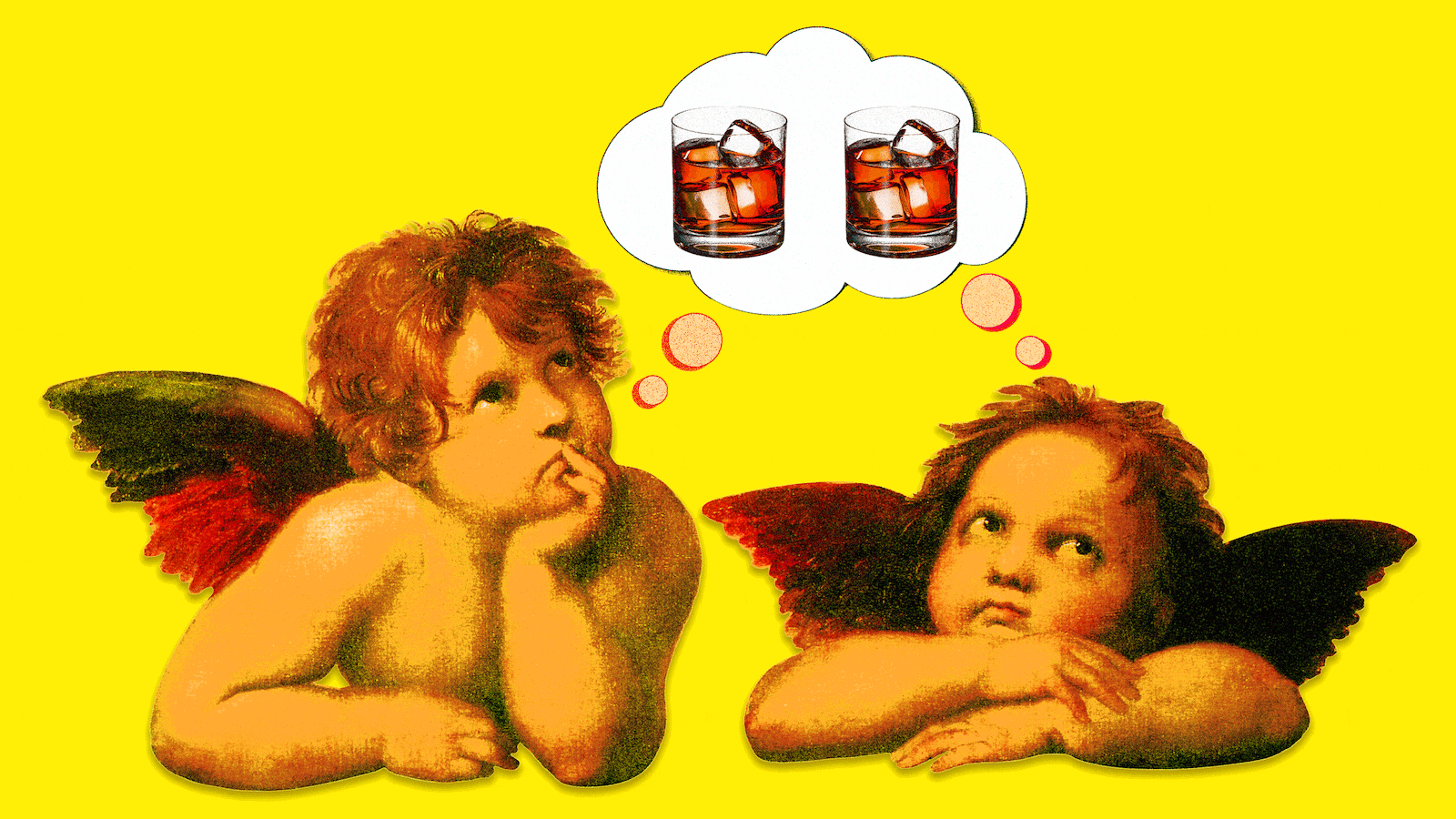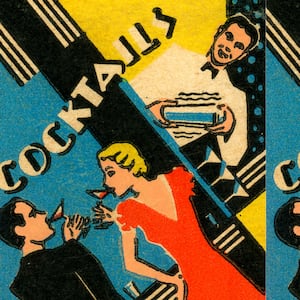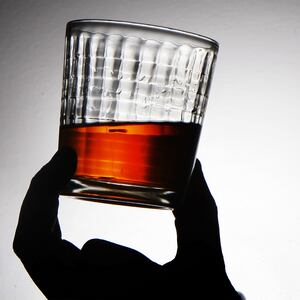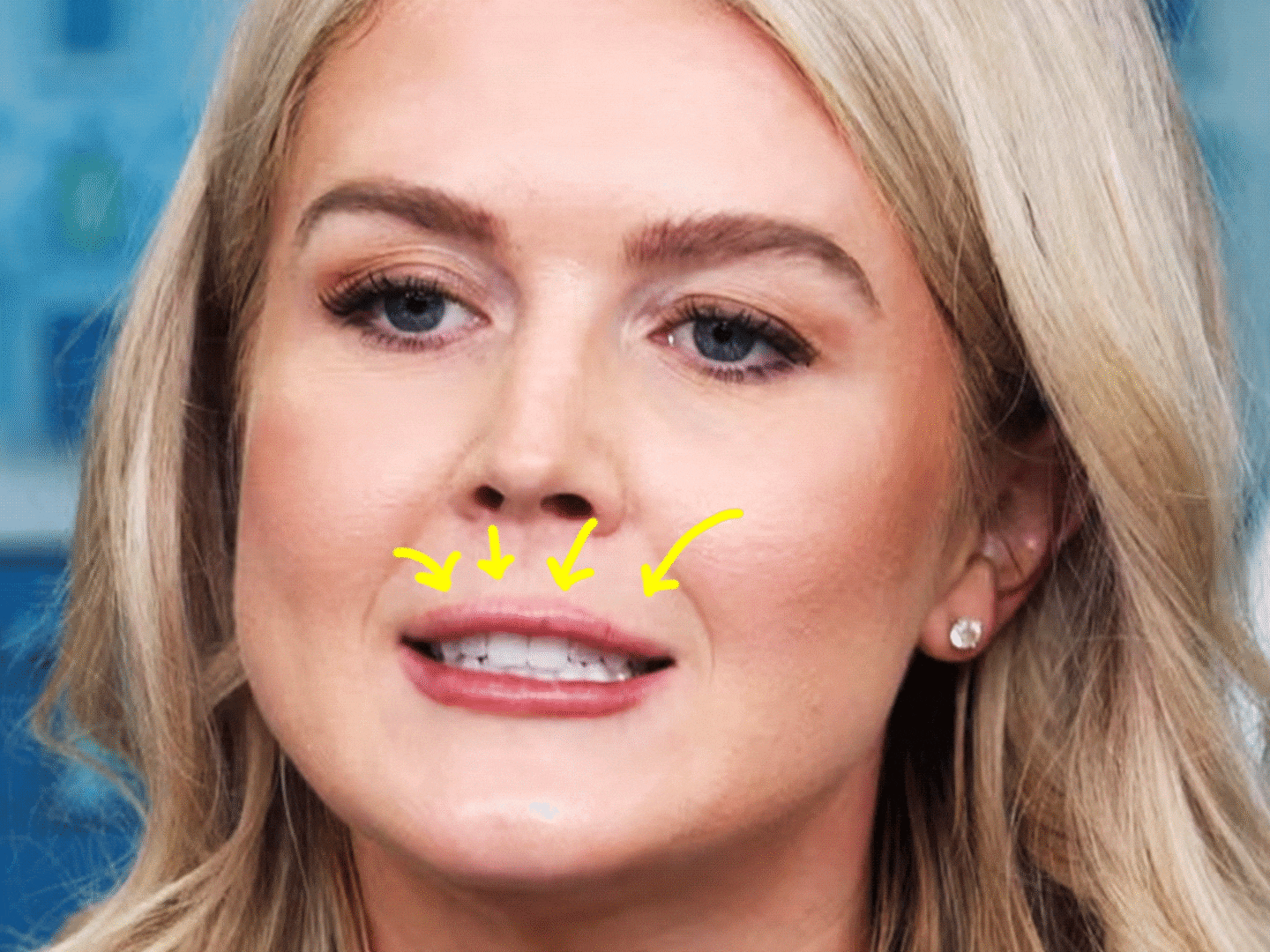If you’ve ever taken a tour of a distillery, you’ll no doubt have heard the ethereal phrase: the angel’s share.
It’s also been used as a name for restaurants, bars and hotels. It’s a bakery in west London and a massage parlor in Lyon, France. It’s a fragrance (with woody whisky notes), an extravagantly flowering bearded iris and an Irish racehorse. It’s a tune by jazz pianist Jacky Terrasson and a song by French crooner Philippe Lavil. It’s been used as a name for numerous brands of wines and spirits, and for one of the most famous spirits auctions in the world. Six twenty-first century books have used it as a title, from crime thrillers to erotic literature. It’s a Ken Loach film featuring a mythical cask of single malt Scotch and a gang of Glaswegian ne’er do wells, starring Scottish whisky expert Charlie Maclean.
But for all its familiarity, have you ever wondered where the phrase the “angel’s share” originated?
Let’s start with what it means—the term refers to the loss through evaporation of the contents of a cask as it ages. That extent of that loss depends upon where in the world the barrel matures. The warmer the climate, the greater the evaporation, and the happier, one might imagine, the angels who have guarded over these slumbering spirits for time immemorial.
The oak casks used to mature both whiskey and many other spirits around the world are impervious. But while the liquid remains secure, air can come and go. So as the spirit “breathes,” alcoholic vapors are released. Anyone who has been in a whiskey warehouse can attest to the smell!
Ask some long-in-the-tooth distillery workers in Scotland or Cognac and they may tell you that it’s a phrase as old as the hills, which they can remember their great grandfathers using, so deeply is it embedded in their inherited memories.
Search hard enough and you may even stumble across a story that puts the words into the mouth of an eighteenth-century priest in the French town of Segonzac in the Charente. Or a mention that dates the phrase to a forgotten past when it was possibly used to describe food left on the table after the Le Réveillon de Noël—the traditional French Christmas Eve dinner—to be enjoyed by any passing heavenly visitor. But trying to find examples of the word being used in descriptions of the manufacture of whiskey or Cognac is a very different matter.
You won’t, for example, find a single use of angel’s share in Alfred Barnard’s Whisky Distilleries of the United Kingdom, which was published in 1887 and is a great treasure trove of information on nineteenth century distilling in Scotland, England and Ireland. And that’s despite the author’s frequent and often quite unprompted excursions into myth, magic and mystery.
Scour as you might the detailed and closely printed seven-page description of a visit to Cognac in 1855 by Charles Dickens, a man who to be frank knew a good saying when he heard one, you won’t find any cherubs in the Charente.
Peruse the pages of the great Scotch whisky books of the 1950s, 1960s, and 1970s wrought by such wordsmiths as Neil Gunn, Sir Robert Bruce Lockhart and David Daiches, none of whom were immune to the charms of a romantic turn of phrase, but you won’t hear even a whisper of celestials. Nor is there a mention in that ultimate whisky yarn Whisky Galore. The little fellows don’t even make it into Michael Moss and John Hume’s definitive The Making of Scotch Whisky (1981). It’s almost as if the angels never existed.
So where did this term come from? Peta Fordham, a pioneering wine and spirits writer, for publications like The Illustrated London News and The Times, and a best-selling author of books about crime and London’s underworld, seems to have first coined the phrase in print in March, 1970. Writing of a visit to Martell in Cognac she commented on the 1.2 million bottles “lost” each year due to evaporation, “the Angel’s Share, as it is known” she added. The column was titled “Drink fit for Angels.” In October of the same year, Cognac brand Bisquit began an advertising campaign in Northern Ireland, which would run for three years, finding its way into The Sunday Times and The Illustrated London News, with the sign-off “Bisquit: the cognac the angel’s share.” As one might imagine the copy writers (and art directors) had a field day: “Bisquit Cognac doesn’t promise you the earth, it promises you heaven.” “Considering the Angels can pick the very finest cognac they wish, it’s very uplifting that they should pick ours…”
In June 1970, Jacques Hine visited Los Angeles as part of a promotional trip to the United States. In explaining the maturation process, he mentioned a five percent spirit loss each year. “In France,” wrote Barbara Hansen, “this is known as the Angel’s Share.” The Los Angeles Times liked the phrase so much that over the next few years it turned up in subsequent articles about Californian brandy and Spanish wines, but it was Cognac to which it belonged, and American writers loved it. In the late 1970s and early 1980s, French Cognac producers launched a charm offensive against the United States in order to recover sales as their main market in the UK declined, and the angel’s share was their Exocet missile. No article about a trip to France or a visit to the U.S. from a leading producer could pass without its mention.
“We refer to it, in a poetic way, as the Angel’s Share,” explained Remy Martin’s Patrick Quien, “we’re building up a stock in heaven.” Referring to the 20 million bottles lost through evaporation each year, Jacques Martell joked that “the angels are always happy in Cognac.”
“The Cognacais call the ethereal fragrance that rises above their region ‘the Angel’s share’” wrote The Boston Globe. Gerard Sturm, international director of the Cognac Bureau, told an audience in Detroit, that the “so called Angel’s Share” was responsible for the longevity of the residents of Charente. His Bureau regularly fed such “angel” stories to the American press, like candy to a baby.
Meanwhile, back in London Cyril Ray had published Cognac in 1973, the first book, it proudly claimed, to have been written on the subject in English and by an Englishman. Ray, a journalist, war correspondent and historian who had turned his hand to wine writing as editor of W & A Gilbey’s Compleat Imbiber magazine (published from 1957 as an annual “entertainment” of commissioned and found writing on food and drink) was a prize-winning author of the old school, who had already published acclaimed books on Chateau Lafite-Rothschild and Bollinger. Ray was already connected in Cognac with the great producing houses before he began his research for the new volume. There were few people of note in the industry to whom he did not talk (some of whom have already been quoted here) and few places he did not visit. His mastery of his subject was impeccable. In his section on the effects of maturation on the new spirit, Ray began by explaining the losses caused by evaporation, dismissively adding (with a patriarchal arrogance only too typical of the time) “referred to by lady journalists and advertisement copywriters as ‘the angel’s share.”’ Somewhat mischievously, he used this as his chapter title.
The famous phrase was only used sporadically in the British national and local press during the 1970s, always in the context of Cognac or occasionally Armagnac, and very often as an eye-catching headline for consumer competitions to win trips to visit producers such as Martell or Hennessy.
Indeed, it was only in 1983 that the angel’s share first appeared in a whisky related book, Phillip Morrice’s Schweppes Guide to Scotch; it would be more than ten years before the phrase found a home in the pages of the Scotch Whisky Association’s handbook, Questions and Answers. The earliest use in the UK press relating to whisky (Irish not Scotch), was 1983; in 1984 in an article on single malt Scotches, The Los Angeles Times explained that a two percent alcohol loss each year as the whisky matured in the “soft Scottish air” was “fondly referred to as the angel’s share.”
In 1989, “the angel’s share” appeared in an article in The Times discussing Pernod Ricard’s plans for their single malt brand Aberlour. The following year they launched an advertising campaign for the brand titled Mephistopheles Share, claiming that “while Aberlour provides the angel’s share, other malts stock Satan’s ample cellars.” The angels, it seemed, were here to stay.
People always have differing recollections of the past, and the collective memories of businesses and institutions in particular can be strange and sometimes wonderful things. Received wisdom and inherited memories can combine to create a genuinely held but misleading view of the past. For all that, some veterans believed that “the angels share” was commonly used in the industry since time beyond, other former distillery and blending company employees were very emphatic that they had no memory of “the angel’s share” being in common usage during their careers. Their memories are very much backed up by the evidence from the printed page.
When the phrase “and this is what we call the angel’s share” falls from the lips of those distillery guides it conjures up an enduring image of celestials and seraphim in the dark corners and eaves of the warehouse, biding their time as events pass them by, while breathing in the heady and intoxicating vapors from the casks below. It somehow seems to capture all that’s magical about Scotch, where it transforms from a mere spirit to something spiritual. In this magical world, still rooms become cathedrals to the ancient art of distillation, distillers the heirs apparent to the alchemists of the late Middle Ages. For journalists and writers the angels are still often the fulcrum around which their stories revolve, as they did for those North American writers covering Cognac in the late 1970s.
But sad to say if we’ve found the origins of “the angels share” anywhere, then it must be not in paradise but on the desk of some forgotten PR company working for the Cognac Bureau or on a copywriter’s notepad in the agency that produced the Bisquit ads of the early 1970s.
These angels turn out to be not heavenly beings but mere marketing metaphors.








